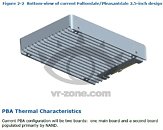- Joined
- Oct 9, 2007
- Messages
- 47,237 (7.55/day)
- Location
- Hyderabad, India
| System Name | RBMK-1000 |
|---|---|
| Processor | AMD Ryzen 7 5700G |
| Motherboard | ASUS ROG Strix B450-E Gaming |
| Cooling | DeepCool Gammax L240 V2 |
| Memory | 2x 8GB G.Skill Sniper X |
| Video Card(s) | Palit GeForce RTX 2080 SUPER GameRock |
| Storage | Western Digital Black NVMe 512GB |
| Display(s) | BenQ 1440p 60 Hz 27-inch |
| Case | Corsair Carbide 100R |
| Audio Device(s) | ASUS SupremeFX S1220A |
| Power Supply | Cooler Master MWE Gold 650W |
| Mouse | ASUS ROG Strix Impact |
| Keyboard | Gamdias Hermes E2 |
| Software | Windows 11 Pro |
As SSDs play catch-up with HDDs on the capacity front, the focus will shift to NAND flash memory designers increasing transistor densities using newer silicon fabrication technologies. In the absence of that, SSD designers will have to cram more number of NAND flash chips to achieve desired high capacities. That throws up two key issues with having too many chips in one place - heat and power. Intel is gearing up to deal with heat on its upcoming "Fultondale" and "Pleasantdale" SSDs for data-centers. Leaked company documents seen by VR-Zone reveal renders of what Intel expects the drives to look like.
Built in the 3.5-inch form-factor the drives are built almost entirely of chunky metal, with a retractable top lid, and its body. The body doubles up as heatsink, it features metal ridges which dissipate heat drawn from the NAND flash chips of the SSD to the air. Internally, the drive will feature at least two PCBs, one which holds the controller, cache RAM (if any), and some NAND flash chips; while the other holds NAND flash chips entirely. How hot can things get? According to the source, the drive could draw as much as 25W of power. That could amount to enough heat to warrant a passive heatsink. Intel is expected to unveil the two drives at IDF Beijing, slated for Q4-2014.


View at TechPowerUp Main Site
Built in the 3.5-inch form-factor the drives are built almost entirely of chunky metal, with a retractable top lid, and its body. The body doubles up as heatsink, it features metal ridges which dissipate heat drawn from the NAND flash chips of the SSD to the air. Internally, the drive will feature at least two PCBs, one which holds the controller, cache RAM (if any), and some NAND flash chips; while the other holds NAND flash chips entirely. How hot can things get? According to the source, the drive could draw as much as 25W of power. That could amount to enough heat to warrant a passive heatsink. Intel is expected to unveil the two drives at IDF Beijing, slated for Q4-2014.


View at TechPowerUp Main Site


